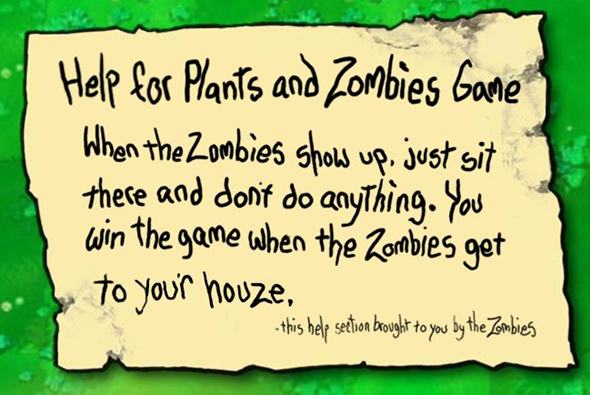The zombie-human relationship is classic, beautiful, and unique. It is a dynamic cycle of constantly reversing roles with no definitive predator or prey. It is a deeply personal connection that, when explored in books and movies, is entertaining but not wholly satisfying.
Though we enjoy watching zombies shuffle around on screen, attempting to devour the brains of characters that—let’s be honest—we usually hope get eaten, we feel something’s missing. To fully appreciate the struggles of zombie survival, we know that we must try it firsthand. Only then can we understand the anxiety, the insanity, the sick satisfaction that comes with outlasting the undead. This is how we will begin to truly understand the zombies and perhaps…ourselves. But how? Will you need a machete? Yes, eventually. But also, like with many of life’s problems, there is a lazier solution. The answer is—of course—video games.
Zombies have been showing up in my video games for as long as I can remember. A common enemy, the undead are sprinkled generously along creepy graveyards, shadowy dungeons, and scary side streets throughout dozens of games. Sadly, there was a time when zombies were mixed in with demons, mummies, and skeletons then simply dropped into the thick of things. They’d show up in games where they had no business being. Zombies can be found lurking around the Wolfenstein and Zelda universes. Though these games both clearly rock, they give the undead a bad name, featuring zombies almost as an afterthought: you simply destroyed these nuisances and moved on to fight bigger enemies like Robo-Hitler or Ganon. But as gaming evolved, zombies garnered the respect they deserve. Slowly, they broke away from their role as a throwaway foe. They stopped blending into the scenery, simply annoying us with their boring intrusions, and started coming after us like they meant it.
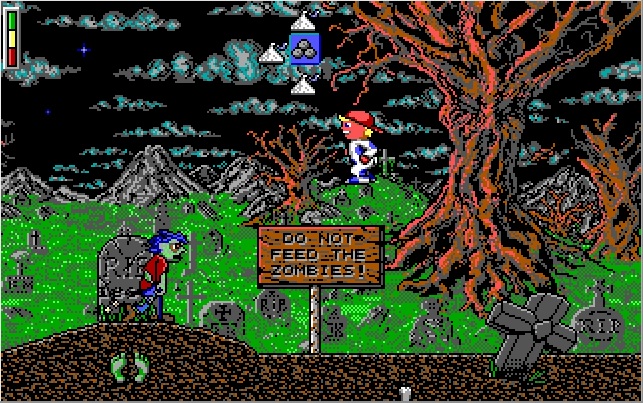 There is so much to learn from the real zombie games. First, let’s examine the innocence and hope of zombie survival. The first legitimate zombies games I can remember share very common themes. Monster Bash has you playing as Johnny Dash, a pajama-clad little badass with a slingshot and a penchant for rescuing kidnapped pets. For such a childish quest, the game is actually pretty gory. A decently designed 2-D DOS platformer from Apogee Software, it’s sort of like a cross between Apogee’s previous games Word Rescue and Duke Nukem. You can’t leave a level without freeing all the captured pets and you get to fight a horrifying cast of creepy creatures during your search. I found the game delightful when I was younger. Also, when you kill a zombie, its head flies off in an explosion of blood and bones, still capable of harming you—thanks to this game, I learned the importance of the double tap before I even knew the name “George A. Romero.”
There is so much to learn from the real zombie games. First, let’s examine the innocence and hope of zombie survival. The first legitimate zombies games I can remember share very common themes. Monster Bash has you playing as Johnny Dash, a pajama-clad little badass with a slingshot and a penchant for rescuing kidnapped pets. For such a childish quest, the game is actually pretty gory. A decently designed 2-D DOS platformer from Apogee Software, it’s sort of like a cross between Apogee’s previous games Word Rescue and Duke Nukem. You can’t leave a level without freeing all the captured pets and you get to fight a horrifying cast of creepy creatures during your search. I found the game delightful when I was younger. Also, when you kill a zombie, its head flies off in an explosion of blood and bones, still capable of harming you—thanks to this game, I learned the importance of the double tap before I even knew the name “George A. Romero.”
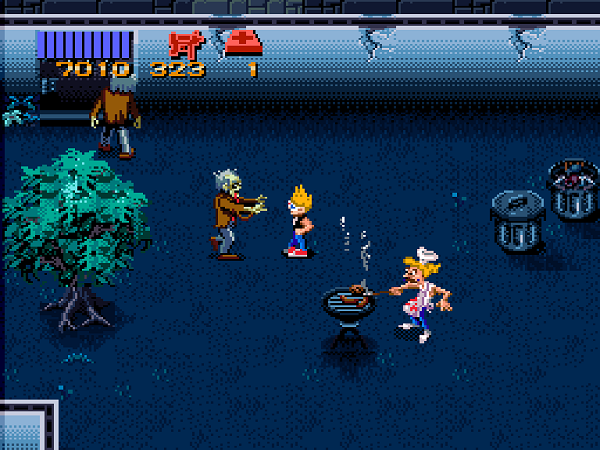 Zombies Ate My Neighbors places a very similar emphasis on rescue. Playing as one of two totally hip kids, Zeke or Julie, you run around trying to save your unsuspecting neighbors from the hordes of the damned. The game still smacks of childish adventure, but it also shifts the focus towards self-preservation. I respect the game’s lessons regarding resourcefulness and priorities. As you move through the game, you pick up a small arsenal of weapons and items to help in your one-man evacuation attempt. Armed to the teeth with soda can grenades, a semi-automatic squirt gun, and a few first aid kits, you do all you can to get your idiot neighbors out alive. Sometimes the zombies beat you to the punch. You can still advance through the game without saving everybody; you just miss out on the bonus points. Also, later in life you find yourself waking up to the 8-bit screams of victims you know you could have saved if only you’d gotten there sooner…or maybe that’s just me.
Zombies Ate My Neighbors places a very similar emphasis on rescue. Playing as one of two totally hip kids, Zeke or Julie, you run around trying to save your unsuspecting neighbors from the hordes of the damned. The game still smacks of childish adventure, but it also shifts the focus towards self-preservation. I respect the game’s lessons regarding resourcefulness and priorities. As you move through the game, you pick up a small arsenal of weapons and items to help in your one-man evacuation attempt. Armed to the teeth with soda can grenades, a semi-automatic squirt gun, and a few first aid kits, you do all you can to get your idiot neighbors out alive. Sometimes the zombies beat you to the punch. You can still advance through the game without saving everybody; you just miss out on the bonus points. Also, later in life you find yourself waking up to the 8-bit screams of victims you know you could have saved if only you’d gotten there sooner…or maybe that’s just me.
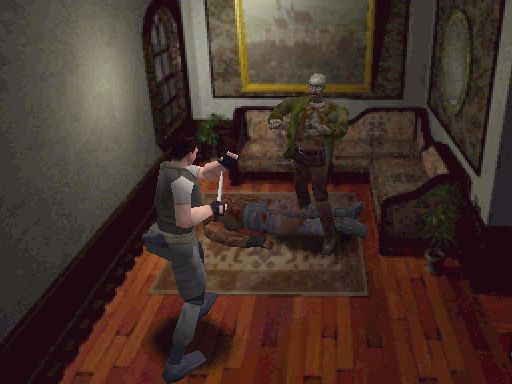 I feel like I almost don’t even need to mention Resident Evil. For most of us, it’s understood that this franchise set the standard in zombie gaming. The original Resident Evil broke onto the scene when graphics were just sharp enough to produce a reasonable level of unmitigated dread. The creepy music, the puzzle/survival format, the cheesy voice acting—it was all perfect. Zombies take a star turn as the key enemy, surrounding your location, slowly breaking in. Since that first adventure through the mansion, there has been a boatload of spin-offs and sequels, with games ranging from slightly tweaked reinventions of the original to ingenious overhauls. As the series expanded, the tone has shifted from survival/suspense to action/horror. From the six slot inventory and magic storage trunks of Resident Evil 2 to the attaché case and eccentric merchant of Resident Evil 4, each game has a slightly different flavor but maintains the overall theme.
I feel like I almost don’t even need to mention Resident Evil. For most of us, it’s understood that this franchise set the standard in zombie gaming. The original Resident Evil broke onto the scene when graphics were just sharp enough to produce a reasonable level of unmitigated dread. The creepy music, the puzzle/survival format, the cheesy voice acting—it was all perfect. Zombies take a star turn as the key enemy, surrounding your location, slowly breaking in. Since that first adventure through the mansion, there has been a boatload of spin-offs and sequels, with games ranging from slightly tweaked reinventions of the original to ingenious overhauls. As the series expanded, the tone has shifted from survival/suspense to action/horror. From the six slot inventory and magic storage trunks of Resident Evil 2 to the attaché case and eccentric merchant of Resident Evil 4, each game has a slightly different flavor but maintains the overall theme.
Resident Evil is the truest instance of a zombie game: defined by the pressure to conserve necessary equipment, to investigate, and to avoid being eaten. Though the scenery and characters are unique to each game, they all follow a formula that has been proven to work. Dead Space and Cold Fear both use a slightly modified version of this formula. It would be easy to describe Dead Space as “zombies in space” and Cold Fear as “zombies on a boat,” but these descriptions are unfair. Both games are clever applications of a well-established scenario and are expertly tailored to highlight an unusual setting.
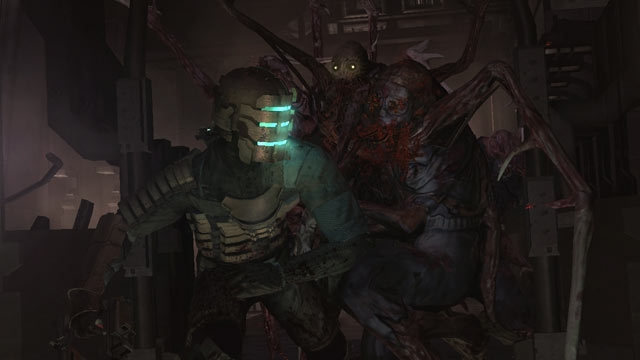 Dead Space is beautifully animated. You play as an engineer named Isaac Clarke. Responding to a distress signal coming from a giant starship, Isaac finds the ship eerily deserted and critically damaged. There are incredible starscapes visible through the giant cracks and gashes of the spaceship. Quickly, it becomes apparent that the crew has been wiped out by sinister aliens who have come to possess their corpses. Armed only with basic space-age tools, the lack of atmosphere and gravity can make things tricky as you battle through the gangs of reanimated astronauts roaming through the ship.
Dead Space is beautifully animated. You play as an engineer named Isaac Clarke. Responding to a distress signal coming from a giant starship, Isaac finds the ship eerily deserted and critically damaged. There are incredible starscapes visible through the giant cracks and gashes of the spaceship. Quickly, it becomes apparent that the crew has been wiped out by sinister aliens who have come to possess their corpses. Armed only with basic space-age tools, the lack of atmosphere and gravity can make things tricky as you battle through the gangs of reanimated astronauts roaming through the ship.

In a very similar role, Cold Fear’s Tom Hansen is sent to check things out on an old Russian whaler in the middle of storm. Some sort of terrible creature from the depths of the ocean has surfaced to infect the ship. Frequently, you’re caught fighting in the rain and the sea spray on deck, with zombies crawling around in every level like undead pirates with glowing red eyes. Most of the game finds your character in close combat with the undead sailors in the cramped underbelly of the ship, where the lighting and angles combine with combat mechanics that perfectly suit the setting.
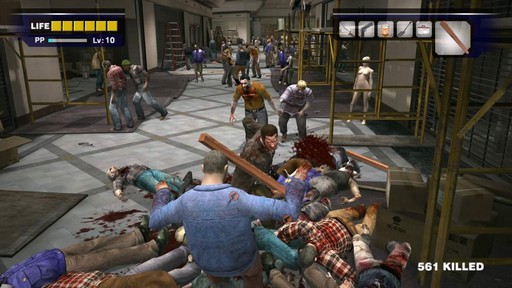 Finally, we come to a breed of zombie games that make you fight so hard to survive that it’s practically revenge. These are games that allow you to take out your bloated aggression on the abominations that you’ve come to despise; perfect for people who are sick and tired of hidden passageways, secret diaries, and locked doors, these games are very run-and-gun.
Finally, we come to a breed of zombie games that make you fight so hard to survive that it’s practically revenge. These are games that allow you to take out your bloated aggression on the abominations that you’ve come to despise; perfect for people who are sick and tired of hidden passageways, secret diaries, and locked doors, these games are very run-and-gun.
For instance, you’ll find that the variety of weapons available in Dead Rising is scaled up to rival the number of zombies encountered. When taking into account the fact that unlocking the “Zombie Genocider” trophy requires 53,594 kills, it’s good to know there’s more than one way to bash a skull. In most games, a simple pistol and the occasional shotgun suffice. This is not the case in Dead Rising, a thinly veiled undead vendetta fantasy. I should mention that the player can choose to rescue innocents from insane survivors and perform other constructive actions, but these activities are simply a distraction from the relentless killing of zombies.
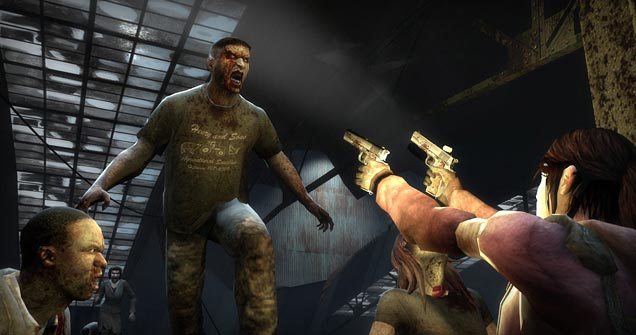 And last, but certainly not least, Left 4 Dead takes the zombie apocalypse to another level entirely. Built for multiplayer flash fights, game-play is a blend of toothskin-shaving escapes and cracked out stand-offs. The game employs several species of the undead, each possessing a unique manner of attack. Left 4 Dead violently drives home the point that the key to surviving a zombie uprising, whether in video games or in real life will probably come down to teamwork and steady aim.
And last, but certainly not least, Left 4 Dead takes the zombie apocalypse to another level entirely. Built for multiplayer flash fights, game-play is a blend of toothskin-shaving escapes and cracked out stand-offs. The game employs several species of the undead, each possessing a unique manner of attack. Left 4 Dead violently drives home the point that the key to surviving a zombie uprising, whether in video games or in real life will probably come down to teamwork and steady aim.
Oh, and Molotov cocktails. They are also key.
Obviously, this list is by no means exhaustive—please feel free to fill in the blanks in the comments if I’ve missed something that deserves a shout-out. After all, it always pays to be vigilant where the undead hordes are concerned.
Peter Malloy is a young man from Philadelphia. He likes animals and cartoons. Sometimes, when slightly injured, he walks around holding his side like his life meter reads “Caution” in yellow.










